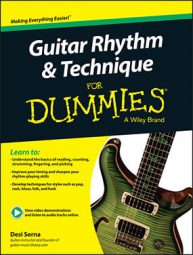One technique that is common to rhythm guitar is the use of string scratching. This is where strings are cut off and damped, but instead of resting and floating over them, the strings are strummed, producing a scratching sound. Perhaps the most well-known example of string scratching among guitar players is Jimi Hendrix’s “Voodoo Child (Slight Return).”
The song opens up with percussive-like scratches that are sounded simply by damping the strings with your fretting hand and strumming across them with your picking hand. To make the scratching more expressive, Jimi used a wah-wah pedal, a foot-controlled device that alters the tone of the instrument with a frequency-sweeping effect.
The following example includes four measures of straight eighth notes. Notice that instead of normal note heads, you see X symbols. This indicates that the sounds are dead, not actual pitches. Practice playing all the downstrokes and upstrokes with your picking hand while damping the strings with your fretting hand.
When you damp the strings, apply only enough pressure to prevent them from ringing. Don’t push the strings down to the fretboard so as to sound pitches.

This is an exercise to set you up for the figure that follows it. It features a very popular type of syncopation that can be a challenge to read in notation, but easy to get the feel for. It’s a pattern that alternates nonconsecutive downstrokes and upstrokes. All together, and keeping a steady down/up motion, it’s down, scratch scratch, up, scratch scratch, down, scratch scratch, up, scratch scratch, and so on.
Rather than try to count this out, look away from the notation example and work out the alternating pattern on your own, continuing it until you play it by feel. Watch this example of string scratching.

The next example mixes chords with scratched strokes. Tablature has been added to this example so that you can follow along. You need to lift your fingers off the E5 chord and reach across the strings during the scratched strokes, moving quickly to get your fingers back in place for the next chord. Before you try to tackle the whole figure, try playing and repeating only measures one and two. When you’re ready, move onto measure three.
Measure three features a bit of the alternating pattern from the previous example and measure four has a new rhythm for you to work out. “China Grove” by The Doobie Brothers follows the same overall rhythm as the example below, using some of the same chords.

This example has far less scratching but may be more challenging to play because it’s tricky to fit in only one quick scratch while sustaining the chords the rest of the time. Notice that the chord changes happen on the upstrokes, the “and” of four in each measure. The style here is reminiscent of “Sister Golden Hair” by America. Watch here to see this example of string scratching played.


